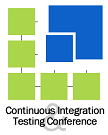Getting the latest netbeans ruby-ide automatically
Update 10/04/2008: THE SCRIPT DOES NOT WORK ANYMORE. The Netbeans changed their nightly build system, you can download the latest version and install netbeans manually from http://bits.netbeans.org/download/trunk/nightly/latest/
I am using netbeans since april 2007 as my primary Rails editor on Linux ubuntu. I used to work with Radrails (now Aptana) because I used to be a java developper and work with Eclipse.
When RadRails "dissapeared", I started looking for alternative IDEs and so far I am very happy with netbeans.
Tor Norbye and his team are very active (and responsive!) and keep delivering new features all every week! The only way to use these features - as far as I am concerned - is to download the latest build from the Continuous Integration server at http://deadlock.netbeans.org/hudson/job/ruby/
To save a bit of time, I have written a script to install the latest netbeans ruby-ide automatically. You need to install the mechanize gem first.
This script will:
- connect to the Continuous Integration server of sun (http://deadlock.netbeans.org/hudson/job/ruby/)
- Guess what's the latest stable build file name and download it to a temp location (depending on your OS)
- rename the old install
- unzip the build to the netbeans installation folder
- delete the downloaded zip from the tmp location
You need to install mechanize:
gem install mechanize
Hten, copy the following code to a ruby file and adapt the last two lines to your configuration. The 1st paramater is the "netbeans installation folder" and the
second one your tmp folder.
Example:
script = NetbeansUpdaterScript.new("/home/jeanmichel/ruby/programs", "/tmp")
script.run
require 'rubygems'
require 'hpricot'
require 'open-uri'
require 'mechanize'
require 'fileutils'
class GenericScript
def download_from(url, save_as)
mechanize = WWW::Mechanize.new
mechanize.get(url).save_as(save_as)
puts "downloaded " + url + " and saved to " + save_as
end
def remove(file_or_directory)
FileUtils.remove_dir(file_or_directory, true) if File.directory?(file_or_directory)
FileUtils.rm file_or_directory if File.file?(file_or_directory)
puts "remove " + file_or_directory
end
def unzip_file(file, target_dir)
system(
"unzip", "-q", file, "-d", target_dir
) or raise "Error extracting (#{$?}): unzip #{file.inspect} -d #{target_dir.inspect}"
puts "unzip " + file + " to " + target_dir
end
def is_using_mac?
RUBY_PLATFORM == /darwin/
end
end
class NetbeansUpdaterScript < tmp_folder = "/tmp" netbeans_installation_folder =" netbeans_installation_folder" netbeans_folder_path =" @netbeans_installation_folder" tmp_folder =" tmp_folder" netbeans_installer_file =" @tmp_folder" doc =" Hpricot(open(" last_stable_build_number =" doc.inner_html" last_stable_build_number=" + @last_stable_build_number.to_s @last_stable_build_number end def url_latest_build get_last_stable_build_number if is_using_mac? " script =" NetbeansUpdaterScript.new(">
I have used this script for a week and it seems to work alright but I'd be happy to hear some feedback about the code or any problem you might have.




 Amsterdam 2008
Amsterdam 2008 2008
2008 2007 & 2008
2007 & 2008
